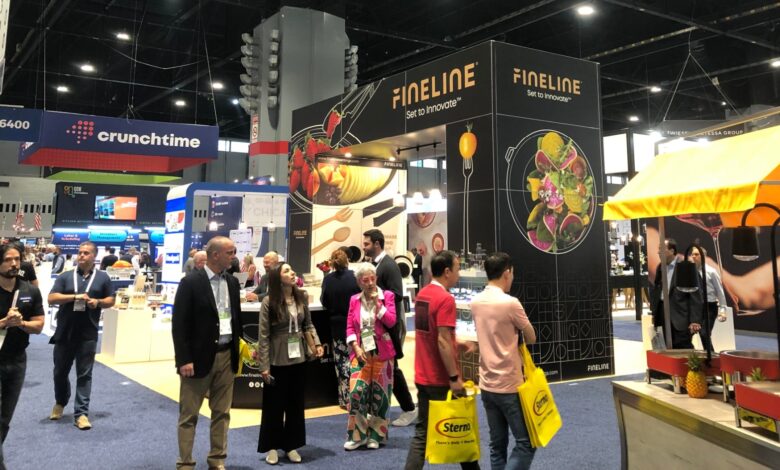Cybersecurity, roller bags and the trouble with takeout

The Show wraps up on Tuesday. | Photo by Joe Guszkowski
What day is it again? After all the walking, talking, learning and eating attendees have done at the National Restaurant Association Show over the past 72 hours, it’s a valid question. We checked and can confirm that it is Monday, May 20. Here’s what the RB team uncovered at the massive foodservice event in Chicago today.
The takeout problem
Takeout and delivery at Applebee’s has soared in recent years, particularly after the pandemic. The casual-dining chain is eager to address that demand with improved facilities and is testing drive-up windows at some locations, said Vicki Hormann, executive director of off-premise at the chain.
The problem? It’s not exactly easy to do at many Applebee’s locations. “We’re a 40-year-old brand,” she said. “Some of our locations are 40, 20 years old. They would require a reconfiguration of traffic flow and the ability to drive up.”
That’s a classic problem for a lot of restaurant chains working to address consumers’ growing need for off-premises sales. Many of their facilities were not exactly built with takeout in mind, requiring creative ideas to accomplish the task.
In Applebee’s case, pickup lockers have been a savior, Hormann said. The chain uses the lockers for curbside and delivery orders. And they don’t require a completely new configuration. —Jonathan Maze
No one is safe from a cyberattack
It is almost impossible to prevent a cyberattack, according to restaurant tech executives who spoke during a panel on cybersecurity Monday. The criminals have simply become too numerous, varied and sophisticated to keep up with.
“It’s like riding a motorcycle,” said Fat Brands CTO Michael Chachula. “It’s not a matter of if you’re going to crash, but when.”
Cyberattackers today run the gamut from state-backed organizations to college kids trying to score a free meal to so-called hacktivists looking to make a point. Many attacks are now perpetrated by AI bots, making them even more difficult to stop. Fat Brands gets hit with hundreds of thousands of hacking attempts every month, Chachula said.
The best thing a restaurant can do to protect itself is buy cybersecurity insurance, he said. Not only will it help defray the costs of a potential attack, but it will also include an audit of a restaurant’s entire system. That helps an operator identify weak spots and invest accordingly. —Joe Guszkowski
The 3 C’s of culinary development
Cravings, community and curiosity are the three big drivers of menu R&D, according to Nancy Kruse, who led off her State of the Plate presentation with those three “Cs” on Monday. To satisfy cravings, comfort still looms large. Cheesy melts, loaded potatoes, biscuit sandwiches and double chicken pot pie—the traditional version topped with a fried chicken thigh—are examples she cited from chain and independent menus.
For the community pillar, Kruse pointed out the prevalence of charcuterie boards and shareables. But chefs are creating new iterations of these favorites, including brunch boards at First Watch and shareable cocktails like Moscow Mules served in a large vessel. Presentation also factors in, with several operators serving shareable food on sheet pans. A total of 44% of restaurant chains now offer chicken wings—the ultimate shareable.
“The higher the tech, the higher the touch” needed in restaurants, said Kruse.
Culinary curiosity on the part of consumers is pushing chefs toward more global preparations and mashups, Kruse added. Recent LTOs at chains played into this demand, such as Velvet Taco’s Potsticker Taco and Del Taco’s Birria Ramen. Operators are also mining TikTok and other social media channels, with a cacio e pepe pizza sandwich an idea that inspired Nouvelle Kitchen & Brewing to create one for its menu. It’s crafted with house focaccia, cheese, black pepper and hot honey garnished with pecorino fennel powder. —Patricia Cobe
Roll with it
The accessory of choice among attendees of the National Restaurant Convention has to be the roller briefcase, a cross between a wheelie suitcase and a traditional business valise. The mini-haulers shift the weight of collected literature and samples from a shoulder strap to a pull-along travois. The surprise is that the devices have become so popular at a time when much of the information dispensed to show attendees is in digital rather than dead-tree form. —Peter Romeo

Roller case ruled the floor. | Photo by Peter Romeo
Room for a new daypart?
Kids have turned the stretch between school and dinner into the snacking daypart. Why should adults be denied something comparable? Mixologist Tony Abou-Ganim suggested during a presentation at the show that restaurants should pull in guests by offering an Aperitivo Hour, an occasion to savor a low-alcohol cocktail like a spritzer while munching on light “bites” like olives. The idea isn’t to provide an alternative to happy hour but to provide a bridge between the end of work and more potent pre-dinner cocktails or wine. —Peter Romeo
Experiential beverages have a moment
On the Show floor, we sampled a delicious slushy-ice cream concoction accented with popping boba balls and our choice of crunchy toppings. (We selected crumbled ginger cookies and crispy chili-lime bits.) We also saw butterfly pea flower drink that changes color. And an Instagram-ready, bubble-topped cocktail that releases a smoke-filled aroma when the bubbles are pierced. –Heather Lalley
Members help make our journalism possible. Become a Restaurant Business member today and unlock exclusive benefits, including unlimited access to all of our content. Sign up here.



